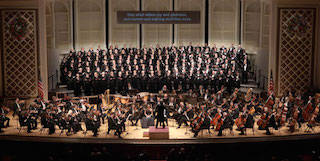
Haydn's "Creation" Fitting Opening for May Festival
Haydn’s oratorio “The Creation” is a hardy perennial at the
Cincinnati May Festival, having been heard most recently in May 2006. It returned Friday night (May 22) at
Music Hall to open the 2015 festival. (This is the 142nd year for
the May Festival, the oldest continuing choral festival in the Western
Hemisphere.)

James Conlon was on the podium for his 36th year as music director. He earned a warm welcome from the crowd, which made its affection clear with cheers and applause as he strode onstage to lead the National Anthem.
There could have been no better opener for the Festival than Haydn’s life-affirming work, which filled the 3,400-seat hall with classic beauty (the audience itself did not fill the hall, a disappointment for opening night, but their enthusiasm was ample).
There were three splendid soloists: soprano Amanda Woodbury (Gabriel and Eve), tenor Ben Bliss (Uriel) and bass-baritone Kristinn Sigmundsson (Raphael and Adam). The centerpiece May Festival Chorus, 110 voices strong and prepared by director of choruses Robert Porco, was accompanied by the Cincinnati Symphony Orchestra (numbering 54), including keyboardist Michael Chertock on harpsichord/continuo.
Balances were excellent. Neither the Chorus, nor the CSO dominated, the soloists projected well and there was rich color and textural fidelity throughout. Conlon led with sensitivity and command, crafting a unity of text and music that was eminently satisfying.
The scene for creation was set with a soft unison C, as the orchestra evoked primordial chaos, a forlorn sound with wandering, unresolved harmonies. Sigmundsson/Raphael sounded the text from Genesis I:1, “Im Anfange schuf Gott Himmel und Erde” (“In the beginning God created heaven and earth”) in a magisterial voice. One electric moment followed another as the Chorus announced “Und es war Licht” (“And there was light”) and celebrated “Und eine neue Welt” (“a new world”) with lightness and joy.
Soprano Woodbury, whose sweet, flexible voice easily carried in oversized Music Hall, shone in Gabriel’s aria “Nun beut die Flur das frische Grün” (“With verdure clad, the fields appear”). The Chorus followed suit in their ringing “Stimmt an die Saiten” (“Awake the Harp”).
Part I closed with a thrilling rendition by the Chorus and all three soloists of the familiar “Die Himmel erzählen die Ehre Gottes” (“The heavens are telling the glory of God”).
Part II, the creation of animal life, is always a delightful portion of Haydn’s “Creation.” And so it was here, with Gabriel’s wonderful “bird aria,” where the CSO bassoons accompanied the cooing of the dove and principal flutist Randolph Bowman gave the nightingale sweet voice. Sigmundsson/Raphael depicted the creation of the great whales, which Haydn paints in warm, dark tone colors with divided violas and cellos.
The three archangels were joined by the Chorus in a tribute to all creation and the glory of God in “Der Herr ist gross in seiner Macht” (“The Lord is great and great his might”) with its soaring crescendos on “ewig” (“forever”).
The lion roared, sheep gamboled and insects buzzed in Sigmundsson/Raphael’s picturesque recitative “Gleich öffnet sich der Erde Schoss” (“Strait opening her fertile womb”) where he sounded an impressive low D on “Gewürm” (“worm”). A blast of trombone illumined “der Tiere Last” (“the heavy beasts”) in Raphael’s imposing aria, “Nun scheint in vollem Glanze der Himmel” (“Now heaven in fullest glory shone”).
Tenor Bliss as Uriel took over for the creation of Adam and Eve, giving them distinct personalities in his aria “Mit Würd und Hoheit angetan” (“In native worth and honor clad”), masculine and dominant in Adam’s case, lyrical for Eve.
“Allelujah! Allelujah!” sang the Chorus in their summation of God’s work, “Vollendet ist das gross Werk” (“Achieved is the glorious work”), which was succeeded by the peaceful instrumental introduction to Uriel’s recitative “Aus Rosenwolken bricht” (“In rosy mantle appears”) which pictured the couple on their own in Eden.
Woodbury and Sigmundsson sang Adam and Eve in the hymn “Von deiner Güt’, O Herr und Gott” (“By thee with bliss, O bounteous Lord”), a lovely sharing with the Chorus of their praise for God. Companion recitatives spelled out their roles, his dominant, hers submissive, followed by a final, tender love duet which asked, “Doch ohne dich, was ware mir der Morgentau, der Abendhauch” (“But without thee what is to me the morning dew, the breath of ev’n”). Principal oboist Dwight Parry and principal cellist Ilya Finkelshteyn played notable roles in these exchanges.
The oratorio closed with a shout-out polyphonic style by the Chorus and soloists, “Singt dem Herren alle Stimmen!” (“Sing the Lord, ye voices all!”).
Encore was the “Hallelujah” chorus from Handel’s “Messiah” (usually reserved for the final night of the Festival, but programmed here). The audience stood for a vibrant sing-along.
The Festival continues at 8 p.m. tonight at Music Hall with “Rule Britannia,” featuring Handel’s Coronation Anthems and “A Sea Symphony” by Ralph Vaughan Williams. May Festival chorus director Robert Porco will conduct. Tickets, information at www.mayfestival.com